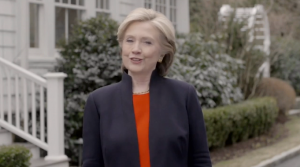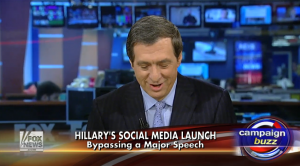“Aren’t We Such a Fun, Approachable Dynasty?”: Clinton’s Presidential Announcement, Cable News, and the Candidate Challenge

Clinton’s Announcement Video
In case you missed it, Hillary Clinton is running for president. On Sunday, April 12, Clinton announced via YouTube video that she would be making a second run for the Oval Office after being narrowly defeated for the Democratic nomination for president in 2008 by Barack Obama. Clinton’s announcement had been anticipated for a few days, once Clinton’s team signed a lease to rent office space for its campaign headquarters in Brooklyn, but on another level, her intentions to run again had been expected for years, a fact that essentially meant that a number of media outlets and political activists already had pre-existing narratives in which Clinton’s candidacy could be framed. In fact, Clinton’s decision to announce on Sunday via social media was so widely anticipated that Saturday Night Live actually managed to parody Clinton’s web video outreach during their cold open even before her video went online.
These narratives reflect what Lance Bennett has identified as a tendency to impose reality television frameworks onto election coverage. Specifically Bennett seems to be talking about the so-called “gamedocs” or competition reality shows, such as Survivor, Fear Factor, or Big Brother, in which contestants are forced to undergo challenges in order to demonstrate their worthiness of winning the competition. For Bennett, such “candidate challenges” actually obscure substantive policy considerations, instead focusing on more superficial storylines. Bennett’s framework, I’d argue, helps us to understand how Clinton can be depicted, from both the right and the left, through similar, but strikingly contradictory narratives as someone who is at once a “celebrity” and also, simultaneously, disdainful of the news media that seemingly create her celebrity status through fawning profiles, and also as someone who is simultaneously too controlling of her messaging and incapable of crafting an effective message about herself. Finally, critics made coded reference to her age, turning her experience as a Senator and Secretary of State into a liability. Thus, for Hillary Clinton, the “candidate challenge” created by different media outlets, is to assume a contradictory set of performances that will meet all of these goals.
It should come as no surprise that the most overt attacks on Clinton’s announcement video came from Fox News. It is no longer controversial to suggest that Fox News has crafted an explicitly conservative approach to narrating the news. Fox has successfully cultivated a large conservative audience in the era of what Natalie Jomani Stroud has called “niche news.” But what is significant about Fox News is what Jeffrey Jones refers to as the news channel’s use of performative language that actually produces a reality in the guise of reflecting on or analyzing it.

Media Buzz on Clinton’s Announcement
This type of performativity functions powerfully in shows such as Howard Kurtz’s Media Buzz, which purports to analyze the media frames that are shaping politics. However, Kurtz’s segment openly reinforces several of the existing narratives used to shape Clinton’s persona independently of any political views she might have. The segment opens with Fox News contributor Mary Katharine Ham gleefully dismissing the announcement as a “snoozefest,” promoting the perception that Clinton is too boring to win the presidency. Similarly, Washington Examiner columnist Susan Ferrechio pushed the idea that the video was an example of Clinton “controlling the message” because she made the announcement via social media rather than during a live speech—despite the fact that most Republicans announced in a similar fashion. Further, by focusing on perceptions of Clinton’s personality, Ferrechio was able to deflect attention away from the actual content of the video, which emphasized (however vaguely) Clinton’s desire to fight for working families. Meanwhile Kurtz himself trotted out the frame (also imposed on Barack Obama) that Clinton might be “covered as a celebrity” even while suggesting, almost in the same breath that she had been “disdainful” of the media. Later that day, Brit Hume, again with little evidence to back up his argument, asserted that Americans were tired of the Clintons’ “weird marriage” and that their story was “old news” and therefore uninteresting to reporters seeking out the next bright, shiny object that could distract them.
Notably, both Kurtz and Bill O’Reilly used the SNL sketch, in which Kate McKinnon, as a simultaneously naïve and controlling Hillary Clinton, attempts to make a selfie video announcement, to attach her to these existing media frames. A clip of Darryl Hammond as Bill Clinton joking about his sex life stands in as evidence of their “weird marriage.” Hillary stumbling repeatedly to be sympathetic reinforces the idea that she is controlling and out of touch. While I did find the SNL clip funny—and think it’s more subtle by far than Fox News’s use of it—it provided Fox with the shorthand to criticize Clinton, even while allowing the network to be in on the joke for a change when it comes to political satire.
That being said, even ostensibly liberal supporters of Clinton placed unrealistic obstacles on her announcement. Bruce Ackerman, among others, writing for The Huffington Post, blasted the video as a “capitulation” to Madison Avenue—i.e., controlling the narrative. Once again, we must turn to Jon Stewart to find a way to navigate the utterly absurd narratives that have been imposed on her. Stewart debunked many of these narratives for their absurd use of dystopian and apocalyptic imagery, pointing out that they vastly exaggerate Clinton’s center-left voting history, even while they also produce a reality for the Fox viewers who are the intended audience. The reception of Clinton’s announcement video can tell us quite a bit, then, not just about perceptions of her as a candidate or the conservative efforts to derail her candidacy. It can also tell us quite a bit about the role of cable news in constructing artificial “candidate challenges” that do little to inform us about how that candidate will actually govern.


